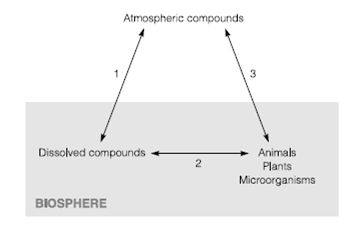Cycling of elements through the biosphere
James Lovelock’s Gaia hypothesis portrays the earth as a self-regulating entity. The basis of this regulation is the involvement in the movement of millions of tons of chemical parts such as carbon, nitrogen and sulfur by the atmosphere, marine and terrestrial environments. The inter-conversion among solid and gaseous compounds of the parts is mostly accomplished through microorganisms, particularly the Bacteria and Archaea. The coupling of spontaneous chemical reactions with those catalyzed by micro- organisms has given the study of these earth-scale transformations the name of biogeochemistry. An overall scheme showing the involvement of organisms in biogeochemical cycling is describe in Figure.

Figure . Biogeochemical cycling. Transformation (1) includes precipitation, occlusion at air/water interfaces; transformation (2) includes growth, fixation, secretion, and decay; transformation (3) includes decay, respiration, and combustion.